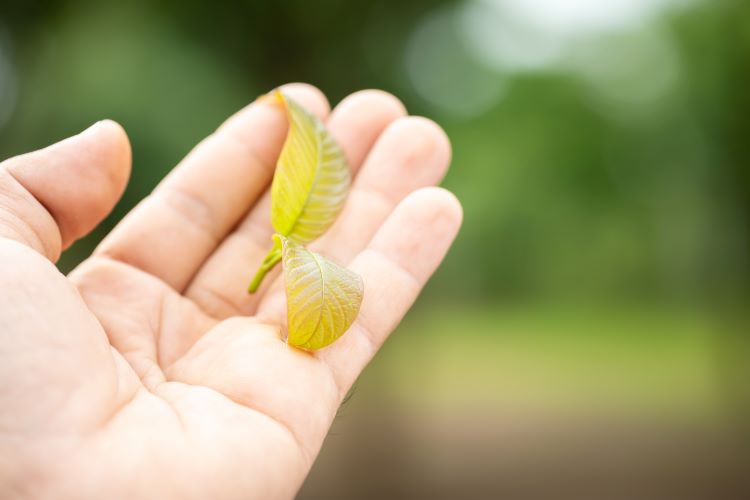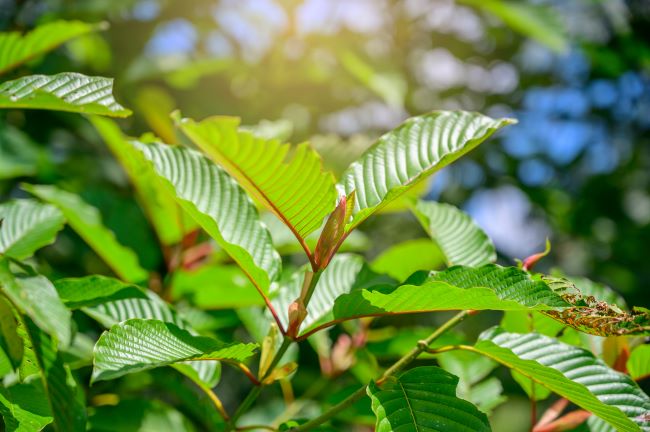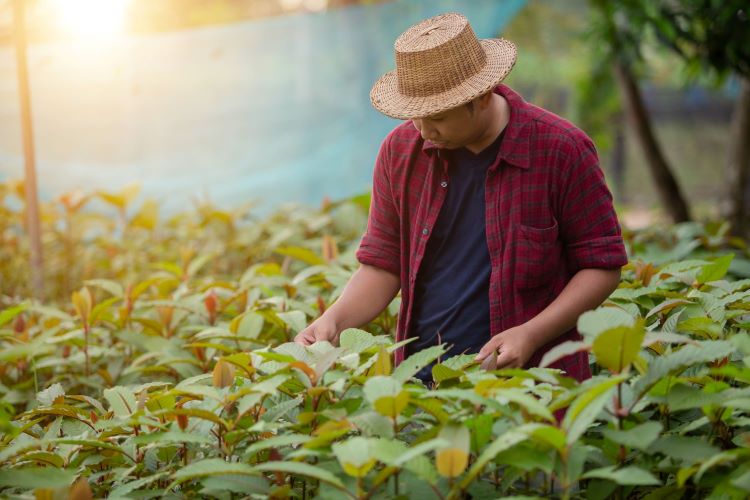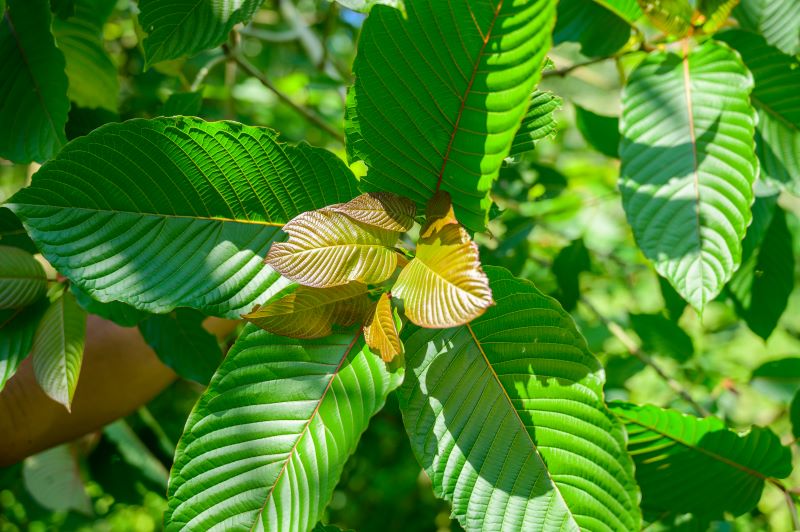Understanding the Kratom Tree: Appearance and Characteristics
The Kratom tree, scientifically known as Mitragyna speciosa, is a tropical evergreen native to Southeast Asia. This towering tree can reach heights of 80 to 100 feet in its natural habitat, making it a striking presence in any landscape.
The Kratom tree is characterized by its broad, glossy leaves, which can grow up to 8 inches in length. These leaves are oval-shaped with pointed tips and feature prominent veins that may appear red, green, or white, depending on the specific strain. Each strain offers unique effects such as relaxation, relief, stimulation and motivation.
The tree’s bark is smooth and light gray, contributing to its majestic appearance.
The Unique Features of Kratom Leaves


The leaves of the Kratom tree are its most distinguishing feature. They are large, dark green, and have a waxy texture that helps repel water in the humid environments where the tree thrives.
The veins of the leaves are particularly significant, as they not only contribute to the leaf’s distinctive appearance but also indicate the type of alkaloid content, which is central to the plant’s effects. These veins can vary in color, often signaling different strains and their unique properties.
The Growth Habits of a Kratom Tree
Kratom trees flourish in tropical climates, where they enjoy warm temperatures and high humidity. In these ideal conditions, Kratom trees grow rapidly, often reaching full maturity within a few years. The tree’s robust root system supports this rapid growth, spreading wide and deep into the soil.
For those cultivating Kratom outside its native environment, pruning can help manage the tree’s size, making it more suitable for smaller spaces.
How to Grow a Kratom Tree


Growing a Kratom tree can be a rewarding but challenging endeavor. Whether you start from seed or cuttings, it requires patience and careful attention to detail.
Starting from Seed
Growing Kratom from seed is notoriously difficult. The seeds need to be as fresh as possible, as they lose viability quickly. Even with fresh seeds, germination rates are low, so it’s wise to plant a large quantity to increase the chances of success.
- Soil: Use rich, fertile soil packed with nitrogen to support the seeds. The soil should remain consistently moist, but not waterlogged, as Kratom seeds prefer a damp environment.
- Sunlight and Water: Kratom seedlings need bright, indirect light, similar to what they would receive on a rainforest floor. Direct sunlight can scorch the delicate leaves. Regular watering is essential, as Kratom seedlings are sensitive to drying out.
- Humidity: To mimic the tree’s native tropical environment, maintain high humidity levels. This can be achieved by misting the seedlings regularly, using a humidifier, or placing them on a pebble tray filled with water.
Patience is crucial when growing Kratom from seed. Germination can be slow, and results are not guaranteed, but with perseverance, you may be rewarded with a thriving plant.
Starting from Cuttings
Propagating Kratom from cuttings can also be challenging, as they are prone to fungal infections and may struggle to develop roots.
- Planting: Place the cutting in a pot filled with damp peat moss or a similar growing medium. Seal the pot inside a plastic bag to maintain high humidity, and keep it out of direct sunlight.
- Caring for Cuttings: Once roots begin to form, gradually introduce the cutting to lower humidity by periodically opening the bag. Eventually, the bag can be removed altogether, and the plant can be moved to a sunny location with indirect light.
How to Care for a Kratom Tree
Caring for a Kratom tree requires attention to its specific environmental needs:
- Soil and Watering: Kratom trees thrive in well-drained, fertile soil with plenty of nitrogen. They are heavy feeders and do not tolerate drought well, so frequent watering is necessary to keep the soil consistently moist.
- Sunlight: Place the tree in a location that receives plenty of indirect sunlight. Direct sunlight can burn the leaves, especially when the tree is young.
- Temperature and Humidity: Kratom trees prefer warm temperatures and high humidity. During colder months, it’s important to protect the tree from frost, which can be fatal. Indoors, using a humidifier or regularly misting the tree can help maintain the necessary humidity levels.
- Fertilization: Regular feeding with a balanced fertilizer, particularly during the growing season, will support healthy growth.
Recognizing and Growing a Kratom Tree
The Kratom tree is a remarkable plant with distinctive features, including its tall stature, broad, glossy leaves with prominent veins, and smooth, light gray bark. Whether you’re interested in growing Kratom from seed or cuttings, understanding and meeting the tree’s specific needs is essential for success. With the right care, you can cultivate a healthy Kratom tree that thrives in your garden or home.
Remember: Always check your local regulations before attempting to grow Kratom, as cultivation laws vary by region.
Growing Green, Red, and White Kratom Trees: Differences and Effects
Kratom trees (Mitragyna speciosa) uniquely produce green, red, or white kratom depending on the leaves’ age and post-harvest processing. Here’s how each type grows and its known effects:
Green Kratom Trees
Harvesting: Green kratom strikes the perfect balance. The leaves are picked mid-growth cycle, right when they reach that vibrant green color that gives the strain its name.
Cultivation: Green kratom trees need plenty of sunshine, humidity, and nutrient-rich soil. Keep a close eye on those leaves and harvest them when they’re at their peak green shade for the best results.
Effects: Green kratom offers the best of both worlds. It provides a gentle energy boost, enhances focus, and elevates your mood without being overly stimulating. It’s a versatile option that’s great for any time of day.
Red Kratom Trees
Harvesting: Red kratom is all about patience. The leaves are harvested when they’re fully mature, resulting in a rich, deep red color and a higher concentration of alkaloids.
Cultivation: While red kratom trees thrive in the same warm, humid conditions as other kratom varieties, it’s crucial to wait until the leaves have reached their full potential before harvesting. This ensures their signature red color and the calming effects they’re known for.
Effects: Red kratom is a favorite for relaxation and tranquility. It’s the perfect way to unwind after a long day or manage everyday discomfort, making it a popular choice for evening use.
White Kratom Trees
Harvesting: Unlike its counterparts, white kratom comes from young leaves, picked at the prime of their growth. These leaves are then carefully dried away from sunlight, a process that helps keep their distinct white veins and energetic properties intact.
Cultivation: Growing your own white kratom requires patience and attention. Harvest the leaves early and ensure they dry in a shaded area to maintain their unique characteristics.
Effects: White kratom is your go-to for a natural energy boost. It promotes mental clarity and motivation, making it a great choice for daytime use or whenever you need to sharpen your focus.
By understanding the different harvesting techniques and processing methods, you can grow kratom trees that produce green, red, or white leaves, each with their own unique effects. Whether you’re looking for energy, relaxation, or a balanced experience, cultivating the right kratom tree can offer a variety of benefits.


